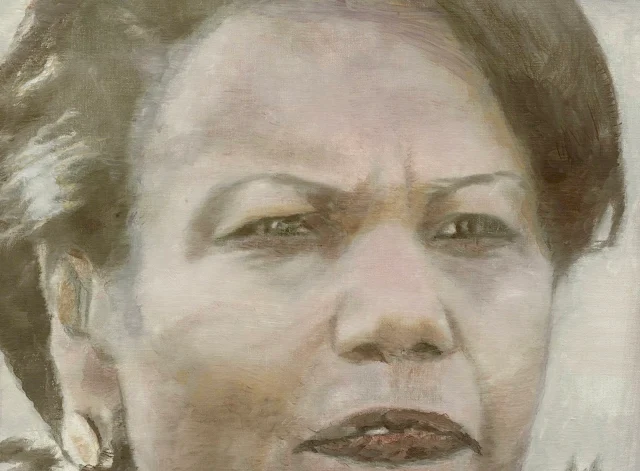Subtlety, History, and the Weight of the Past
Luc Tuymans is an artist whose work seems to whisper rather than shout, yet it carries an emotional and historical weight that lingers long after the initial viewing. Often working with subdued palettes and enigmatic imagery, Tuymans has become a leading figure in contemporary painting by tackling themes such as memory, history, and the lingering effects of trauma. Today, let’s take a closer look at how Tuymans uses paint to explore the delicate boundaries between remembering and forgetting.
 |
| Luc Tuymans - |
Early Influences: Art in the Wake of Conflict
Born in Belgium in 1958, Tuymans grew up in a country scarred by its colonial history and by the echoes of World War II. These formative years in a post-war Europe steeped in moral ambiguity have deeply informed his practice. Tuymans has often spoken about his fascination with the Holocaust and the pervasive sense of unease that characterized much of 20th-century European history. Yet, rather than depict scenes of violence or trauma directly, Tuymans chooses to paint what he calls the “aftermath”, the shadows and traces that remain.
 |
| Luc Tuymans - Solitude |
His early training was in film, and the cinematic quality of his paintings is immediately evident. Many of his works appear cropped or out of focus, as if they are film stills frozen in time. This deliberate blurring of the image serves to create a sense of distance, mirroring the difficulty of truly comprehending traumatic events. Tuymans' approach is understated, but it is precisely this subtlety that allows his work to haunt viewers, quietly asking them to confront the murky areas of their collective and personal histories.
The Power of the Unspoken: The Language of Ambiguity
Luc Tuymans' paintings are often characterized by their muted tones, faded blues, dull greens, grays, and beiges. This choice of palette is deliberate; it reflects the fading of memory, the erosion of clarity over time. His works rarely offer straightforward narratives. Instead, they suggest, they imply, and they leave space for viewers to bring their own experiences and interpretations to the image. In a time where we are bombarded with explicit visuals, Tuymans' restraint feels radical.
His 1992 painting “Gas Chamber” is emblematic of his approach. Rather than a graphic depiction, the work is almost bland—an empty, nondescript room painted in washed-out colors. It is this very banality that makes it so chilling. Tuymans doesn’t sensationalize history; instead, he presents it in a way that forces us to confront the quiet horror of ordinary spaces turned monstrous. The lack of explicit detail invites us to fill in the gaps, making the viewer complicit in the act of remembering.
 |
| Luc Tuymans - Gas Chamber |
Painting History: Colonialism and Moral Blind Spots
In addition to his exploration of European history, Tuymans has also turned his attention to Belgium’s colonial past. The series “Mwana Kitoko,” for instance, deals with the figure of King Baudouin and the country’s fraught relationship with the Congo. Again, Tuymans resists the urge to depict the violence of colonialism directly. Instead, he paints portraits that seem almost washed out, drained of vitality, evoking the moral hollowness at the core of the colonial enterprise.
 |
| Luc Tuymans - Mwana Kitoko |
One of his most well-known works, “The Secretary of State,” is a portrait of Condoleezza Rice, painted in 2005. The image, with its cool colors and detached expression, captures the distance and impassivity often associated with power. Tuymans isn’t interested in heroizing or villainizing his subjects; rather, he presents them in a way that encourages us to consider their humanity, or the lack thereof. In this way, his paintings often serve as a critique of the mechanisms of power and the narratives that sustain them.
 |
| Luc Tuymans - The Secretary of State |
The Fragility of Memory: A Painterly Approach
Tuymans has often described his work as being about “authentic forgery,” a term that captures the tension between truth and artifice in his practice. He is acutely aware that history is not a fixed, objective record but rather a collection of narratives shaped by those in power. By painting his subjects in a way that is deliberately vague or out of focus, Tuymans emphasizes the fragility of memory and the difficulty of accessing an unvarnished truth.
In many of his paintings, there is a sense of quiet unease, an acknowledgment that something significant lies just beneath the surface, yet it remains elusive. This is particularly evident in works like “Still Life,” where a simple, everyday object, like a bowl of fruit, seems to take on a more sinister quality. The image is drained of color, and the familiar becomes unsettling. Tuymans taps into the idea that what we see is always influenced by what we know, and that even the most mundane subjects can carry the weight of unspoken histories.
The Legacy of Luc Tuymans: Silence as a Form of Resistance
Luc Tuymans’ paintings are not loud, but they are powerful. In their quietness, they force us to slow down, to consider, and to confront uncomfortable truths. He offers no easy answers, no dramatic revelations. Instead, he presents us with fragments, glimpses, and shadows, leaving us to grapple with what is left unsaid.
His legacy is one of subtlety and nuance, a reminder that sometimes the most profound statements are made not through direct confrontation but through implication. In a world that often demands clarity and resolution, Tuymans embraces the unresolved, the partial, and the ambiguous. His work is an invitation to sit with discomfort, to understand that history is not always a coherent narrative but often a collection of fleeting, fragmented memories.



.jpg)







No comments:
Post a Comment